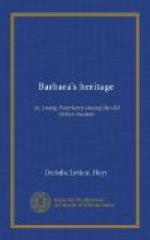“It is the magnitude of Michael Angelo’s conceptions that puts him among the very first of painters; and it is the conception of these frescoes that makes them the most notable paintings in the world. We must dwell on this for a moment. When the work was begun it was the artist’s intention to paint on the end wall, opposite the altar, the Fall of Lucifer, the enemy of man, who caused sin to befall him. This was never accomplished. Then he designed to cover the ceiling (as he did) with the chief Biblical scenes of the world’s history that are connected with man’s creation and fall—to picture all these as looking directly forward to Christ’s coming and man’s redemption; and then to complete the series, as he afterward did, by painting this great Last Judgment over the altar. Is it not a stupendous conception?
“Let your eyes run along the ceiling as I talk. God is represented as a most superbly majestic Being in the form of man. He separates light from darkness. He creates the sun and moon. He commands the waters to bring forth all kinds of fish; the earth and air to bring forth animal life. He creates Adam: nothing more grand is there in the whole realm of art than this magnificent figure, perfect in everything save the reception of the breath of eternal life; his eyes are waiting for the Divine spark that will leap into them when God’s finger shall touch his own. He creates Eve. In Paradise they sin, and are driven out by angels with flaming swords. Then, a sad sequence to the parents’ weakness, Cain murders his brother Abel. The flood comes and destroys all their descendants save Noah. He who has withstood evil is saved with his family in the ark, and becomes the father of a new race.”
“And do the pictures at the corners, and the single figures, have anything to do with this subject?” asked Malcom, after a pause, during which all were busy following the thoughts awakened by Mr. Sumner’s words.
[Illustration: MICHAEL ANGELO. SISTINE CHAPEL, ROME.
THE DELPHIAN SIBYL.]
“Yes, indeed; nothing here is foreign to the one great thought of the painter. The four irregular spaces at the corners are filled with representations of important deliverances of the Jewish people from evil,—David slaying Goliath, the hanging of Haman, the serpent raised in the wilderness, and Judith with the head of Holofernes. The connection in Michael Angelo’s mind evidently was that God, who had always provided a help for His people, would also in His own time give a Saviour from their sins.
“Ranged along the sides you see seven prophets and five sibyls: the prophets foretold Christ’s coming to the Jewish world, and the sibyls sang of it to the Gentile world.




